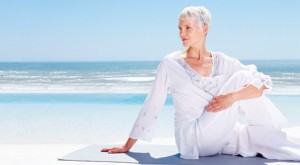By Sylvia A. DiLorenzo, M.A., E-RYT 500 –


Yoga comes from an ancient body of knowledge. The word “yoga” came from the Sanskrit word “yuj” which means yoke, unite, or integrate. Yoga is about the integration of the mind, body, and spirit. For these three to be integrated, emotion, action, and intelligence must be in balance. The Yogis formulated a way to achieve and maintain this balance and it is done through moving the body (depending on the ability of the person), breathing, and meditation.
Yoga postures help to improve circulation, strengthen the muscles and bones, improve balance and generally improve or maintain better health. In Yoga, students learn to focus on their breath and gain some control over the breath. By focusing on the breathing, the students prepare their minds for meditation. In meditation students learn to quiet or calm the mind. Meditation can be as simple as focusing on the breath and being in the present moment. Meditation is fundamentally non-religious! However, one can use meditation as a centering tool to quiet the mind and to go into prayer. Yoga helps the physical body, helps one focus and relieves everyday stress.
In recent years there have been several articles, and even a book, written about how “yoga can wreck your body.” Understandably, that has caused fear amongst many. At the heart of those works is the necessity of finding a highly-qualified registered instructor, the necessity of honoring one’s body and the necessity of never going into pain or doing something that one is not comfortable with or not physically able to perform.
A new study by geriatrician Neela K. Patel, MD, MPH, CMD, and colleagues at the University of Texas Health Science Center at San Antonio, published in The Journal of Alternative and Complementary Medicine, October 2012, Vol. 18, No. 10:902-917, reports on fairly extensive number of double-blind studies. The study was framed around the following question: Among older adults in community and institutional settings, is yoga superior to other physical activity with respect to its effect on physical functioning measures and health related quality of life. The study strongly suggests that yoga may be the best form of physical activity for older adults — even the frail elderly in their 80’s and 90’s –. In a conversation with another yoga therapist, Dr. Patel states: “Yoga may be superior to conventional physical-activity interventions in elderly people.”
In summary the study states: “Yoga not only improves health-related quality of life, but also enhances walking and balance, muscle strength, cardiovascular health, blood pressure, sleep and functioning of other systems. Yoga may also have psychosocial benefits through prevention and control of common health and emotional problems linked with aging.” With regard to physical functioning, yoga practitioners had improvements in timed one leg standing and forward flexibility as well as an improved sense of well-being, energy, and fatigue, as compared to an aerobic exercise control group. There was also a significant improvement in posture, as noted by a decrease in the forward curvature, or kyphosis, seen in many adults. “Body flexibility had significantly improved in both the upper and lower body in the yoga group, with improved lower-limb muscle endurance and walking speed…
A significant decrease in sleep latency and increase in number of hours slept were found after six months of yoga intervention.” In a private conversation with Carol Kruchoff, the Director of Yoga Therapy for Seniors at Duke University’s Center for Integrative Medicine, Dr. Patel said that the ability to individualize the practice and the social nature of yoga is extremely important and that the most important aspect may be yoga’s impact on enhancing the activities of daily living and helping people maintain confidence and independence. She said: “Having the leg strength to get up and down from the bed to go to the toilet, and the arm strength to open a door, can make a tremendous difference in an older adult’s life…And yoga goes beyond physical health, to help relieve anxiety and calm the mind, which is also critical.” Overall, the authors of above study, the authors of many other studies, and other yoga therapists “recommend yoga for older adults with careful observation and monitoring.”
SYLVIA DI LORENZO, MA, E-RYT 500
Sylvia is registered with Yoga Alliance (the only registry for certified yoga teachers) at the E-RYT 500 level (she has over 1000 hours of training and over 5000 hours of teaching); member of the International Association of Yoga Therapists; certified in Yoga Therapy for Seniors from Duke University’s Center for Integrative Medicine; certified as an Exercise Specialist in Posture for Aging & Osteoporosis from the Meeks Institute; certified in Yoga Therapy for Depression & Mood Balance; and participated in Mindfulness-Based Stress Reduction training for professionals with Jon Kabat-Zinn.
FOR INFORMATION: SEE AD ON PAGE 23
239-768-1458
www.yogawithsylvia.net
 Southwest Florida's Health and Wellness Magazine Health and Wellness Articles
Southwest Florida's Health and Wellness Magazine Health and Wellness Articles

